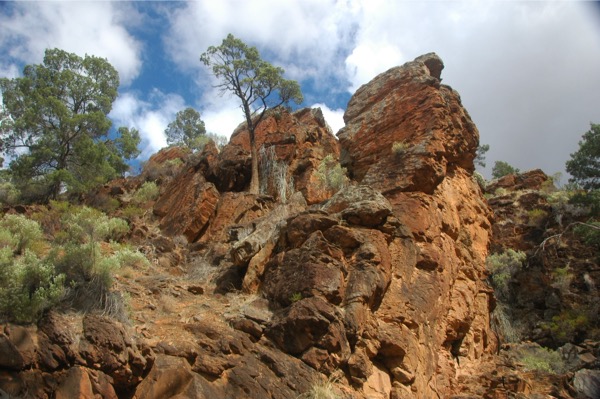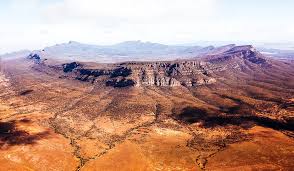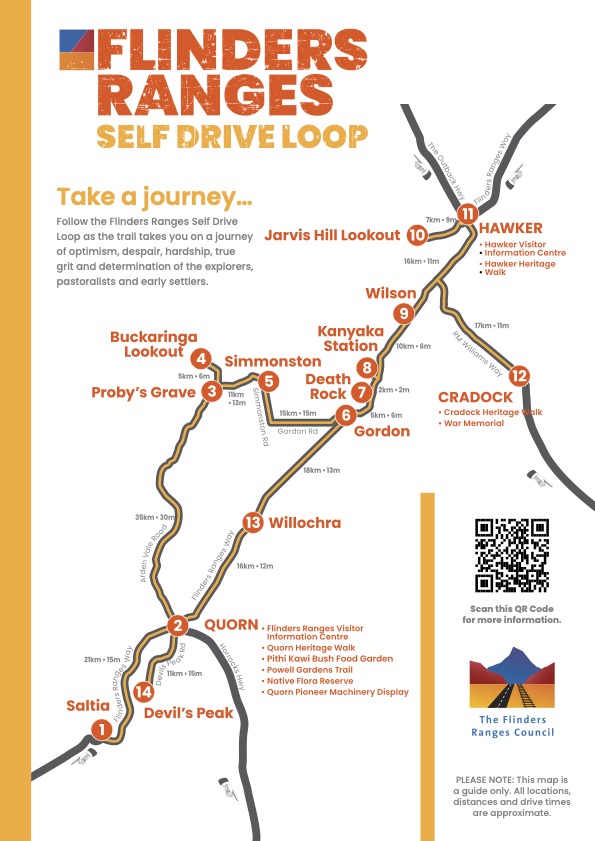
Captain Matthew Flinders RN (1774 – 1814), English navigator and cartographer, was the first to circumnavigate Australia and identify it as a continent and not two islands. Flinders made three voyages to the southern ocean between 1791 and 1810. In the second voyage, George Bass and Flinders confirmed that Van Diemen’s Land (now Tasmania) was an island. On his third voyage, Flinders circumnavigated the mainland of what was to be called Australia. Returning to England in 1803, he recorded details of his voyages for future publication, and proposed the new continent be named ‘Australia’, as an umbrella term for New Holland and New South Wales – a suggestion taken up later by Governor Macquarie. Unfortunately Flinders did not live to see the publication of his widely praised book and atlas, A Voyage to Terra Australis.

Staying at the SBSA will allow you to take the easy drives to picturesque places including Warren Gorge, Brachina Gorge, Wilpena Pound, Blinman, Hawker, Cradock. Cradock is renowned for its sunsets on the horizon, pub food and art on display.
The Flinders Ranges extends north-south for about 430 Km, from Mount Hopeless to near Port Pirie in South Australia. The ranges are composed of folded and faulted sediments of the Adelaide Geosyncline and this sequence of sediments were deposited in a large basin on the edge of the ancient continent of Rodinia about 840 million years ago.
Fossils in the Adelaide Geosyncline – discovered in the Ediacara Hills of the northern Flinders in 1946, are of worldwide significance as some of the oldest examples of fossilized animal life ever found. Dating from the very end of the Neoproterozoic, in 2004 the location gave its name to the last geological period of the era, the Ediacaran.
During the Cambrian period approximately 540 million years ago, the area underwent folding, buckling and faulting into a large mountain range, the eroded stumps of which can today be seen as the Mount Lofty and Flinders Ranges. Before erosion, the ranges are though to have been up to 12,000 metres (40,000 feet) high.
Wilpena Pound is a world class attraction – a large, sickle-shaped, natural amphitheatre covering nearly 80 square kilometres (~31 Sq Miles), containing the range’s highest peak, St Mary Peak (1,170 m (3,840 ft)) and adjoins the Flinders Ranges National Park.
The northern ranges host the Arkaroola wilderness sanctuary and the Vulkathunha-Gammon Ranges National Park. The central part of the ranges are notable for the Pichi Richi scenic railway and the southern ranges feature Mount Remarkable National Park and Port Germein gorge.
The Flinders Ranges extends north-south for about 430 Km, from Mount Hopeless to near Port Pirie in South Australia. The ranges are composed of folded and faulted sediments of the Adelaide Geosyncline and this sequence of sediments were deposited in a large basin on the edge of the ancient continent of Rodinia about 840 million years ago.
Fossils in the Adelaide Geosyncline – discovered in the Ediacara Hills of the northern Flinders in 1946, are of worldwide significance as some of the oldest examples of fossilized animal life ever found. Dating from the very end of the Neoproterozoic, in 2004 the location gave its name to the last geological period of the era, the Ediacaran.
Flora of the Flinders Ranges consist of species adapted to a semi-arid environment such as sugar gum, cypress-pine, mallee and black oak. Areas near Wilpena Pound with more moisture, support grevilleas, guinea flowers, liliaceae and ferns. Reeds and sedges grow near permanent water sources such as springs and waterholes.

Since the eradication of dingos and the establishment of permanent waterholes for stock, the numbers of red kangaroos, western grey kangaroos and euros in the Flinders Ranges have increased. The yellow-footed rock-wallaby, which neared extinction after the arrival of Europeans due to hunting and predation by foxes, has now stabilized. Other marsupials include dunnarts and planigales. Insectivorous bats make up a significant proportion of mammals in the area.
There are a large number of bird species including parrots, galahs, emus, the wedge-tailed eagle and small numbers of water birds. Reptiles include goannas, snakes, dragon lizards, skinks and geckos. The streambank froglet is an endemic amphibian.
Further afield and an easy drive from Quorn you can reach Warren Gorge or take a day trip to Brachina Gorge, Wilpena Pound, Blinman, Hawker, Cradock (renowned for sunsets, pub food and art on display). Other interesting towns out of Quorn include Hammond, Bruce, Melrose, Moockra Tower and Laura (home of the Golden North Ice Cream).
Attached below is the map, courtesy of the Flinders Ranges Council for a suggested self-drive loop north to Hawker and south to Saltia.



